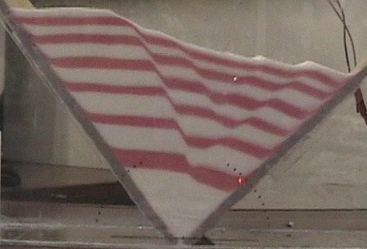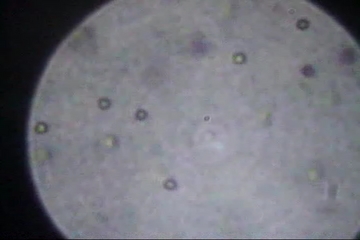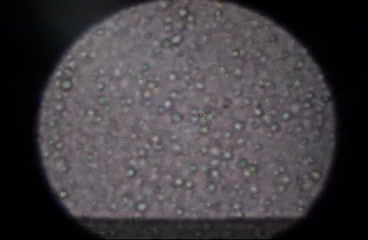Soap film
|
|
|
The moment of
the
rupture was photographed, fortunately, by Ms.Yamaguchi in a seminar for
undergraduate students.
Why is the edge of film not smooth?
Viscous fingering
|
|
|
These patterns
were formed by blowing air into honey sandwiched between two
transparent acrylic plates.
It was a little tough to take photos while blowing.

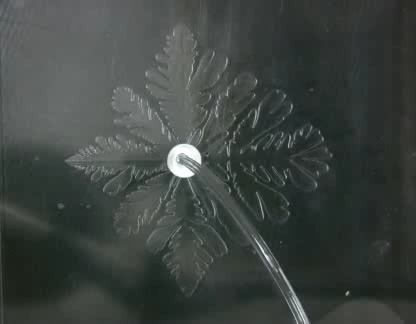
![]()
Air was pushed into silicone oil using a
syringe in
these experiments.
The
experiments were carried out with Ms. Ikeno, Ms. Inoue, and Ms.
Funakoshi during the
open days at the department of physics of Nara Women's univ, Nara,
Japan, 2007.
In the right
hand video, there were small bumps in a square lattice on the surface
of the bottom
acrylic plate.
Drying cracks
|
|
|
Cracks in
mixture
of water and soybean flour were induced by natural drying (left) and by
ten-minutes drying in oven (right). Crack patterns differ depending on
drying method.
If left alone
a
long time, mold colonies begin to show patterns after a few weeks....
| |
|
| |
|
300g of Potato
starch was dried naturally for a week.
The left photo was taken
with transmitted light from a fluorescent tube, and the right photo,
with natural light.
The size of this acrylic
container was 30 x 30 cm and tilted slightly.
The thickness of the starch
layer increased from about 1mm to 6 mm in the container (from right to
left).
Please see my paper
"Fracture Patterns Induced by Desiccation in a Thin Layer" if you are
interested in this theme.
Faults in granular matter
|
|
Nested faults in dry glass
beads in a V-shaped container were formed by opening the V-walls
gradually.
This experiment was
prepared and photographed by Ms. Kurumatani.
This is the color version of the photograph in our paper "The Creation
Process of Faults in Quasi-static Deformation".
Brownian motion
Brownian motion of
polystyrene beads with 1 micrometer diameter, Moritex D-0374 (left) and
of milk fat globules (right) in water, which were photographed with a
microscope.
These experiments were carried out with Ms.Iwata,
Ms.Ikeno, and Ms.Ito in the open day, 2005.
Thermal convection
Fluid
convection was observed by heating silicone oil from the bottom on a
hot plate.
This
cell pattern was visualized by using fine glittering powder (sold
with the name of “pearl powder” ).
These
experiments were carried with Ms.Ikeno, Ms. Inoue and Ms.Funakoshi in
the open day, 2007.
Bioconvection
Fluid convection is caused
by swimming of micro organisms in high concentrated slurry of
Paramecium.
Plese see my paper
"Bioconvection and front formation of Paramecium Tetraurelia" for
detail.
BZ
reaction

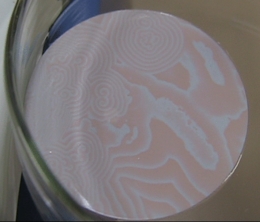
![]()
(Left) Oscillatory chemical reaction in a 10ml of beaker.
(Right) Spatio-temporal pattern on a paper filter (membrane
filter) impregnated with solution. This video is sped up at 10 times the speed.
These experiments were carried out by
Ms. Miyata, Ms. Inoue, and Ms. Ikeno in the open day 2006, with the support of Prof. Kitahata.
Tornado
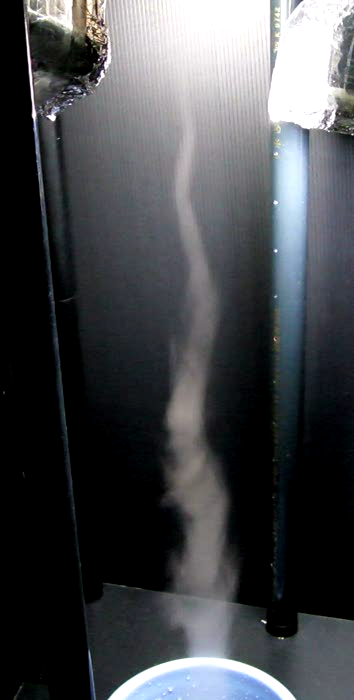
![]()
(Left) A small tornado created by a generator, which was visualized by a ultrasonic mist generator.
(Right) This
generator was made with Ms. Okamoto, Ms. Kabutoya, and Ms. Yamamoto
in the open day, 2008.
